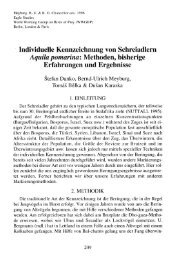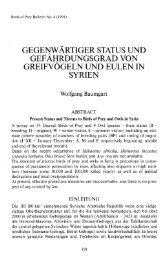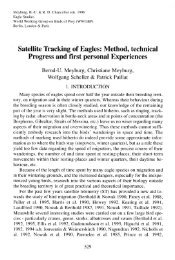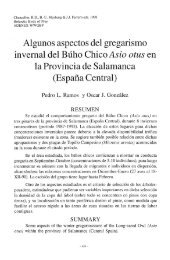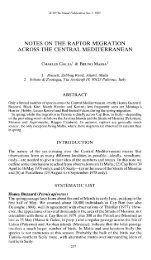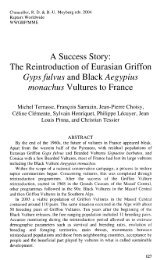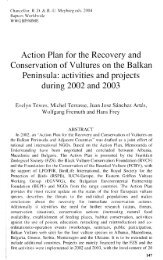THE STATUS OF THE BEARDED VULTURE IN CORSICA
THE STATUS OF THE BEARDED VULTURE IN CORSICA
THE STATUS OF THE BEARDED VULTURE IN CORSICA
Create successful ePaper yourself
Turn your PDF publications into a flip-book with our unique Google optimized e-Paper software.
ICBP Technical Publication No. 5, 1985<br />
<strong>THE</strong> <strong>STATUS</strong> <strong>OF</strong> <strong>THE</strong> <strong>BEARDED</strong> <strong>VULTURE</strong><br />
<strong>IN</strong> <strong>CORSICA</strong><br />
F. BOUVET<br />
Parc Naturel Regional de Corse, B.P. 417, 20184 Ajaccio, France<br />
Until recently, little was known about the Bearded Vulture (Gypaetus barbatus)<br />
in Corsica. Population estimates varied between two to three and seven to ten<br />
pairs, and only two eyries were known. The 'Parc Naturel Régional' of Corsica<br />
therefore decided to investigate the bird's status on the island and, following<br />
extensive fieldwork, it can confidently be said that the population consists of 14-16<br />
pairs. So far (1982), 14 eyries in the territories of 7 different pairs have been<br />
discovered, with the ranges of a further 7 being fairly precisely known.<br />
The density of the species in Corsica is higher than in the Pyrenees, occupied<br />
nests being situated as little as 4.5km apart. Productivity seems to be lower than<br />
in the Pyrenees but may be sufficient to maintain the population at its present level<br />
on the island. In 1981, of the six pairs known at the time, at least three laid eggs<br />
and a minimum of three young hatched, of which two fledged. In 1982 it would<br />
appear that there were no serious breeding attempts.<br />
Many interesting details of behaviour have been recorded. Food remains were<br />
collected from the eyries and analysed to determine the diet. The food supply is<br />
fairly abundant; numerous domestic and semi-wild animals roam the mountains<br />
throughout the year and in summer they are joined by large migrating flocks of<br />
goats and sheep. Mouflons are on the increase but remain very localized and do<br />
not form a major source of food.<br />
Compared with other European populations, the Bearded Vulture has survived<br />
remarkably well in Corsica. It has not been persecuted, or hardly so (for instance,<br />
we do not know of any skin originating from Corsica in museum collections,<br />
whereas skins from Sardinia are common). While there is no immediate threat to<br />
the species on the island, the ever-increasing human presence in the mountains,<br />
and the disappearance of the migrant grazing flocks, are causes for concern. It is<br />
vital that traditional pastoralism be maintained and the Mouflon encouraged to<br />
spread out once more into the whole of its former range throughout the mountains<br />
of the island. Efforts must be made to increase public awareness of the richness<br />
and fragility of this apparently barren landscape so that the tranquillity of the<br />
habitat remains undisturbed.<br />
Our knowledge is still very incomplete, but these discoveries are nonetheless<br />
encouraging. It is apparent that Corsica is an important refuge for the Bearded<br />
Vulture in Europe, and if it can be allowed to continue to prosper one may hope<br />
that the species will one day recolonize Sardinia.<br />
129
130 F. Bouvet<br />
REFERENCES<br />
GEROUDET, P. 1980. Notes sur le statut actuel du Gypaète barbu en Europe et autour de la<br />
Méditerranée. In: Rapaces Méditerranéens. PNRC & CROP, Aix en Provence, pp.<br />
73-75.<br />
TERRASSE, J.-F. 1981. Recensement, succès de la reproduction et alimentation de Gypaetus<br />
barbatus dans les 'Pyrénées françaises. In: Rapaces Méditerranéens. PNRC & CROP,<br />
Aix en Provence, pp. 76-78.<br />
THIBAULT, J.-C. 1977. Le Statut des Rapaces de Corse. PNRC 46 pp.



